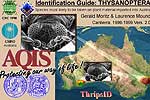Taxonomists
have two primary objectives: recognising species, and producing classifications.
Although both of these are useful to non-taxonomists, the first was particularly
emphasised during a recent visit to the ANIC by developmental biologist,
Gerald Moritz, from the University of Halle-Wittenberg. Together with
the author, a data-matrix for 175 pest species of thrips worldwide was
constructed, involving 350 character states, and a LucID identification
key generated. The next phase of this project is to incorporate more
than 1500 photomicrographs into the system, together with biological
information. The product is targeted at economic biologists, but the
range of illustrations will be valuable for teaching as well as for research
taxonomists. The finished CD-ROM will be available commercially in time
for an international conference of thrips and tospovirus workers in July
2001. The LucID software, developed in Brisbane, enables a taxonomist
to generate such information systems rapidly - the pest thrips data matrix
was compiled and the key generated within 10 days. For non-taxonomists
the keys are exceptionally intuitive, indeed lucid. All character states
and all taxa are displayed on-screen in two boxes at the same time. The
user 'drags and drops' a character state of their choice from one box
to a third, and species without that state then move to a fourth box.
Alternatively, the computer will assess the shortest route through the
data and suggest a 'best' character, or even permit a 'bingo' choice
for species with unique attributes. A system like this, but including
only 85 species and 550 colour pictures, was produced last year for AQIS,
and the number of thrips species their staff now identify annually has
increased by more than 300%, demonstrating a close correlation between
customer satisfaction and taxonomic lucidity!
(ANIC News 16 (2000), 10: Laurence Mound: Taxonomic Lucidity). |
